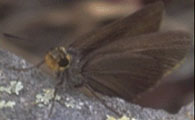Native Plants
Search for native plants by scientific name, common name or family. If you are not sure what you are looking for, try the Combination Search or our Recommended Species lists.
Bromus inermis
Bromus inermis Leyss.
Smooth Brome
Poaceae (Grass Family)
Synonym(s):
USDA Symbol: BRIN2
USDA Native Status: L48 (NI), AK (NI), CAN (NI), GL (I), SPM (I)
This species includes subspecies that are North American natives. However, it also includes subspecies that are not native to North America, e.g. Bromus inermis ssp. inermis, Smooth Brome. Non-native taxa are not treated in this database.
A rhizomatous, clump-forming, perennial grass bearing many light green (sometimes purple- or bronze-tinged), narrow, usually hairless spikelets in a loose, much-branched terminal cluster.
This drought-resistant Eurasian species was deliberately introduced into the United States around 1880 as a hay and pasture grass and for reseeding western ranges. It has since gone wild throughout the United States and much of Canada (except the far north) and is now one of our most common weedy grasses; in some areas it is considered an undesirable plant because of its aggressiveness. However, its deep roots make it an excellent soil binder, protecting against erosion. Relished by all kinds of livestock, it is a fine forage. The species name means "unarmed," alluding to the spikelets, which do not have the long bristles characteristic of some of Smooth Brome's relatives. A rare variant has hairy spikelets.
From the Image Gallery
Plant Characteristics
Duration: PerennialHabit: Grass/Grass-like
Root Type: Fibrous
Leaf Arrangement: Alternate
Leaf Complexity: Simple
Leaf Venation: Parallel
Fruit Type: Caryopsis
Size Notes: Up to about 4 feet tall.
Leaf: Green
Bloom Information
Bloom Color: YellowBloom Time: May , Jun , Jul
Distribution
USA: AK , AR , AZ , CA , CO , CT , DC , DE , IA , ID , IL , IN , KS , KY , LA , MA , MD , ME , MI , MN , MO , MS , MT , NC , ND , NE , NH , NJ , NM , NV , NY , OH , OK , OR , PA , RI , SC , SD , TN , TX , UT , VA , VT , WA , WI , WV , WYCanada: AB , BC , MB , NB , NL , NS , NT , ON , PE , QC , SK , YT
Native Distribution: Throughout most of North America, except parts of far north; least common in southeastern United States.
Native Habitat: Roadsides, fields, pastures, nursery plots, and waste places.
Growing Conditions
Water Use: MediumLight Requirement: Sun
Soil Moisture: Dry
CaCO3 Tolerance: Low
Butterflies and Moths of North America (BAMONA)
|
Orange-edged Roadside-Skipper (Amblyscirtes fimbriata)  Adult Food Source |
Find Seed or Plants
Find seed sources for this species at the Native Seed Network.
National Wetland Indicator Status
| Region: | AGCP | AK | AW | CB | EMP | GP | HI | MW | NCNE | WMVE |
| Status: | UPL | UPL | FACU | UPL | UPL | FACU | UPL | FAC |
From the National Organizations Directory
According to the species list provided by Affiliate Organizations, this plant is on display at the following locations:Native Seed Network - Corvallis, OR
Bibliography
Bibref 1186 - Field Guide to Moths of Eastern North America (2005) Covell, C.V., Jr.Bibref 1185 - Field Guide to Western Butterflies (Peterson Field Guides) (1999) Opler, P.A. and A.B. Wright
Search More Titles in Bibliography
Additional resources
USDA: Find Bromus inermis in USDA PlantsFNA: Find Bromus inermis in the Flora of North America (if available)
Google: Search Google for Bromus inermis
Metadata
Record Modified: 2022-03-09Research By: TWC Staff